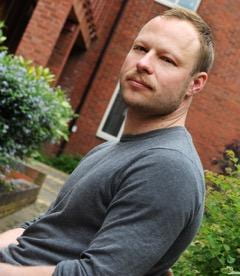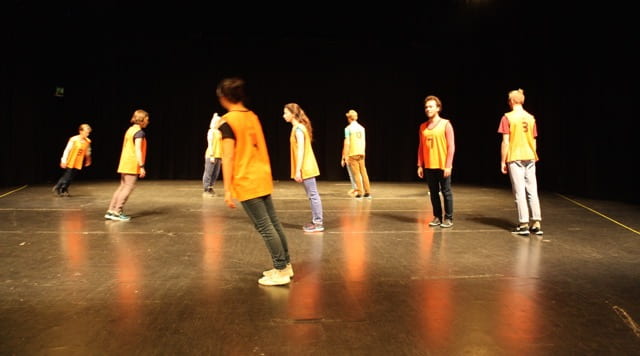 Dr. Guido Orgs received his training in both Performing Dance (Folkwang University of the Arts) and Psychology (University of Dusseldorf). After completion of his PhD in Cognitive Neuroscience, he performed with German Dance Company NEUER TANZ/VA WÖLFL. At the Institute of Cognitive Neuroscience, UCL, he conducted research on how we perceive other people’s movements and how the brain mechanisms of movement perception underlie the aesthetics of dance and the performing arts.
Dr. Guido Orgs received his training in both Performing Dance (Folkwang University of the Arts) and Psychology (University of Dusseldorf). After completion of his PhD in Cognitive Neuroscience, he performed with German Dance Company NEUER TANZ/VA WÖLFL. At the Institute of Cognitive Neuroscience, UCL, he conducted research on how we perceive other people’s movements and how the brain mechanisms of movement perception underlie the aesthetics of dance and the performing arts.
Since September 2015 he is a Lecturer in Psychology at Goldsmiths, University of London teaching Psychology of the Arts and Neuroaesthetics. Funded by an ESRC transformative research grant he currently investigates synchrony in performing dance, collaborating with Choreographer Matthias Sperling Dr Annemieke Apergis-Schoute, Cambridge University, and Dr Daniel Richardson, UCL. Here, he explores dance as a means of social bonding.
Why do human and other animals dance? Across all known cultures people dance, to worship, to entertain, to show off, or simply to have fun. Despite its universal nature, dance has been rarely studied by Psychologists and Cognitive Neuroscientists alike. This is surprising, given that dance shares many similarities with music and language.
Evolution suggests at least two potential reasons for why people dance. Firstly, to have sex: Many bird species engage in very complex choreographies of sound and movement to attract mating partners, for example the Australian Lyrebird. Secondly dancing in groups might foster bonding between group members. People who move together, begin to like each other.
Dance for social cohesion
We recently completed a research project in which we asked groups of people to perform a series of choreographic tasks. In one condition people were asked to swing their arms together in synchrony. In a second condition, groups performed the same choreographic tasks asynchronously. Using smart watches, we measured each participant’s movements and computed how much the group moved in unison. Following these dance workshops, participants completed a range of tasks that measured how much the group had bonded. Participants who synchronised with each other most successfully, liked each other more than participants who hadn’t synchronized with each other. We also asked group members to decide to to go to a restaurant together and choose from a range of options.
The time that participants took to decide on a restaurant depended on how well they had synchronised before. The more successfully movements were coordinated in a group, the longer did it take for group members to make a decision. Presumably, this is because more opinions were heard and the group found it more difficult to reach a compromise. In groups that hadn’t bonded so well, decisions were made faster, perhaps with less consideration for individual opinions.
But is participants’ movement as well as synchrony important?
Dancing together thus helps to form social bonds. Yet, especially in Western societies, relatively few people perform or engage in dancing or making music themselves. Most people assume a more passive role, watching other people dance or making music together, whether live, on the internet or TV in shows such as BBC’s “Strictly Come Dancing”. Do some of the prosocial effects of dancing together translate to the engagement of audiences with performative art?

In collaboration with Choreographer Matthias Sperling we recently investigated this question: Does movement synchrony predict the spectator’s enjoyment of a live performance? We developed a piece for ten performers “Group study”. The piece was based on the same choreographic tasks that were used in our previous study on the social effects of synchrony. Ten performers performed these tasks in synchrony or in asynchrony, while audiences rated their enjoyment of the performance using tablet computers.
Indeed, movement synchrony on stage predicted how much spectators enjoyed the performance, but only if spectators engaged with the performance as whole. Spectators who didn’t like the performance, also disliked watching moments of high synchrony. In contrast spectators who enjoyed the performance also enjoyed moments of high synchrony the most. Spectators who were indifferent to the performance as a whole, neither enjoyed synchrony nor asynchrony. In other words, if spectators didn’t’ care about watching the performance, they also didn’t care about synchrony. Arguably, watching dance is not everyone’s cup of tea…
If you’d like to hear more about the social neuroscience of dance, come and visit us at Siobhan Davies Dance Studios on the 27th of May, 7 pm. You will be able to explore some of the choreographic tasks that we use in our research and hear more about our research! Tickets may be bought online here.